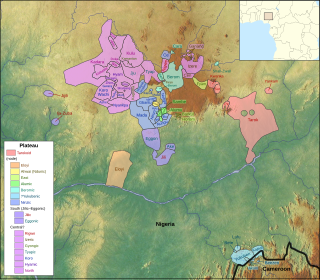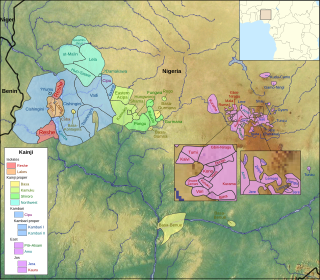Related Research Articles

The forty or so Plateau languages are a tentative group of Benue–Congo languages spoken by 15 million people on the Jos Plateau, Southern Kaduna, Nasarawa State and in adjacent areas in central Nigeria.
The Kurama or T'kurmi or Akurmi language is a Kainji language of Nigeria. Kurama speakers are found in the central northern Nigerian states of Kaduna, Bauchi, Borno, Kano, Jigawa and Plateau.

The Angas, Angas–Sura, or Central West Chadic languages are a branch of West Chadic languages spoken in Plateau State, north-central Nigeria.

The Kainji languages are a group of about 60 related languages spoken in west-central Nigeria. They form part of the Central Nigerian (Platoid) branch of Benue–Congo.
The five Tarokoid languages are a branch of the Plateau family spoken in central Nigeria, just north of the middle reaches of the Benue River. Tarok itself has 300,000 speakers, with Pe and Sur about 5,000 each. Yangkam is severely endangered, being spoken by around fifty elderly men.
The South Plateau languages, also known as Jilic–Eggonic, are spoken in central Nigeria. Eggon has 150,000 speakers and Jili perhaps 100,000.
The four Beromic languages are a branch of the Plateau languages spoken in central Nigeria by approximately 1 million people.
The four scattered and poorly attested Alumic languages form a branch of the Plateau languages of central Nigeria.
Ahwai, also called the Ndunic languages, is a Plateau language cluster spoken to the southwest of Fadan Karshi in Sanga LGA, Kaduna State, Nigeria. Most villages are located at the foot of the Ahwai Mountains in Kaduna State.
Jili (Lijili) is a Plateau language of Nigeria. It is one of several languages which go by the ambiguous name Koro.
Kwanka, or Kwang (Kwaŋ), is a dialect cluster of Plateau languages in Nigeria.
The Rigwe language, Nkarigwe, is a Plateau language of Nigeria spoken by the Irigwe people mainly found in Bassa Local Government Area of Plateau State.
Idun (Idũ), or Dũya, is a poorly attested Plateau language of Nigeria. Its classification is uncertain, but it may be closest to Ashe.
Lela or C'lela is a Kainji language of Nigeria. It is known as Cilela in Hausa, and it is also known as Dakarkari, because it is spoken by the Dakarkari people
kuSur–Myet, also known as Sur (Nsur), Tapshin, or Myet, is a minor Plateau language of Bauchi and Plateau states, Nigeria. There are two closely related dialects, Súr and Myet.
Firan or Fəràn is a Plateau language closely related to Izere. Most Firan speakers are multilingual in Firan, Hausa, English, Iten and sometimes Berom.
Tunzu (Tunzuii), or Itunzu, also known as Duguza (Dugusa) in Hausa, is a Kainji language of Nigeria.
Ziriya (Jiriya) and Sheni (Shaini) constitute a Kainji language of Nigeria. They are geographically but perhaps not linguistically distinct.
Gwara (iGwara) is a newly discovered Plateau language of Nigeria. It was first reported by Roger Blench in 2009. There are marked similarities with the related language Idun, but some of these may be due to borrowing.
Nincut (Aboro) is a Plateau language of Kaduna State, Nigeria belonging to the Beromic branch. Blench estimates 5,000 speakers in 2003. It is spoken 7 km north of Fadan Karshe in Kaduna State. Nincut is not recorded in Ethnologue or Glottolog.
References
- ↑ Yangkam at Ethnologue (18th ed., 2015) (subscription required)
- 1 2 Blench, Roger (2019). An Atlas of Nigerian Languages (4th ed.). Cambridge: Kay Williamson Educational Foundation.
- ↑ Blench, Roger. 2006. The Yangkam language of Central Nigeria and its affinities . Cambridge: Kay Williamson Educational Foundation.
- ↑ Blench, Roger. 2004. Tarok and related languages of east-central Nigeria.